Built more than 1800 years ago, the magnificent Pantheon still stands as a reminder of the great Roman Empire. It borders the Piazza della Rotonda, a rectangular square with at its center an eighteenth-century fountain crowned with an obelisk.
This constantly crowded square, situated in the historic center of Rome, is not far from Piazza Navona. With its thick brick walls, large columns and 43 m. high dome, this cylindrical building made an immediate impression on us. As the best-preserved example of an ancient Roman monumental building, the Pantheon has been enormously influential in Western architecture from at least the Renaissance on. Even in its present state, the Pantheon allowed me a glimpse into the marvelous and stunning world of Roman architecture. This wonderful example of second century Roman architecture boasts mathematical genius and simple geometry that even today still impressed an architect like me.
The present Pantheon was built on the site of an earlier building commissioned by Marcus Agrippa during the reign of Augustus (27 BC – 14 AD), The Augustan Pantheon, along with other buildings, was destroyed in a huge fire in the year 80 AD. Domitian rebuilt the Pantheon, which was burnt again in 110 AD. It was completed by the emperor Hadrian and probably dedicated about 126 AD. In 202, the building was repaired by the joint emperors Septimius Severus and his son Caracalla (fully Marcus Aurelius Antoninus), for which there is another, smaller inscription on the architrave of the façade. In the walls at the back of the Pantheon’s portico are niches, perhaps intended for statues of Julius Caesar, Augustus Caesar, and Agrippa, or for the Capitoline Triad, or another set of gods.
![Jandy and the author. The inscription above reads: M•AGRIPPA•L•F•COS•TERTIVM• FECIT meaning "Marcus Agrippa, son of Lucius, made [this building] when consul for the third time."](http://www.benjielayug.com/wp-content/uploads/2016/05/Pantheon-15.jpg)
Jandy and the author. The inscription above reads: M•AGRIPPA•L•F•COS•TERTIVM• FECIT meaning “Marcus Agrippa, son of Lucius, made [this building] when consul for the third time.”
In 609, the Byzantine emperor Phocas gave the building to Pope Boniface IV, who converted it into a Christian church and consecrated it to St. Mary and the Martyrs (Latin: Santa Maria ad Martyres) on May 13, 609.
The building’s consecration as a church saved it from the abandonment, destruction, and the worst of the spoliation that befell the majority of ancient Rome’s buildings during the early medieval period. This circular building, with a front portico of three rows of large granite Corinthian columns (eight in the first rank and two groups of four behind) under a pediment, has a rectangular vestibule that links the porch to the rotunda. The rotunda, under a coffered concrete dome, has a central opening (oculus) to the sky.
Here’s some interesting trivia regarding the Pantheon:
- The name Pantheon refers to the building’s original function as a temple for all the gods. However, the generic term pantheon has sometimes been applied to other buildings in which illustrious dead are honored or buried.
- Its date of construction has been confused as Hadrian retained Agrippa’s original inscription – M·AGRIPPA·L·F·COS·TERTIVM· FECIT meaning “Marcus Agrippa, son of Lucius, made [this building] when consul for the third time.”
- It is one of the best-preserved of all ancient Roman buildings, in large part because it has been in continuous use throughout its history.
- Almost two thousand years after it was built, the Pantheon’s dome, substantially larger than earlier domes, is still the world’s largest unreinforced concrete dome, spanning 150 Roman ft. It was the largest dome in the world until 1436 when Brunelleschi‘s 42-m. dome of Santa Maria del Fiore in Florence was constructed.
- The building was originally approached by a flight of steps but these were eliminated after later construction raised the level of the ground leading to the portico.
- The Pantheon was probably constructed by using an elaborate setup of costly wooden scaffolding.
- The grey 39 ft. (11.9 m.) high, 5 ft. (1.5 m.) diameter granite columns that were actually used in the Pantheon’s pronaos, each weighing 60 tons, were quarried at Mons Claudianus in the eastern mountains in Egypt. Each of these was dragged, on wooden sledges, more than 100 kms. (62 miles) from the quarry to the Nile River, floated by barge when the water level was high during the spring floods, then transferred to vessels to cross the Mediterranean Sea to the Roman port of Ostia. There, they were transferred back onto barges and pulled up the Tiber River to Rome. After being unloaded near the Mausoleum of Augustus, it was necessary to either drag them or to move them on rollers to the construction site 700 m. away.
- Most of the bombards for the fortification of Castel Sant’Angelo used about 90% of the bronze from the ceiling of the Pantheon’s portico, ordered melted down by Pope Urban VIII (1623 to 1644). The remaining amount was used by the Apostolic Camera for various other works. It is also said that the bronze was used by Bernini in creating his famous baldachin above the high altar of Peter’s Basilica (however, one expert states that the bronze for the baldachin came from Venice).
- The large bronze doors to the cella, once plated with gold, are ancient but not the original ones of the Pantheon. The current doors, manufactured too small for the 40 Roman ft. high door frames, have only been there since about the 15th century.
- The height to the oculus (30 Roman feet in diameter) and the diameter of the interior circle are the same, 43.3 m. (145 Roman feet or 141 feet 8 inches), so the whole interior would fit exactly within a cube. In a similar note, the interior could house a sphere 43.3 m. in diameter. If the dome of the rotunda were flipped upside down it would fit perfectly inside the rotunda.
- From the outside, the Pantheon appears rectangular in shape but it is only the first small room (cella) that has corners. The rotunda is completely round.
- The Pantheon has no windows. The oculus, an engineering gem of the Roman world at the dome’s apex, and the entry door are the only natural sources of light in the interior.
- Though often drawn as a free-standing building, the Pantheon abuts a building at its rear which helps buttress the rotunda but was no interior passage from one to the other.
- The interior of the dome was possibly intended to symbolize the arched vault of the heavens. Throughout the day, the light from the oculus moves around this space in a reverse sundial effect.
- The oculus, still lined with the original Roman bronze, also serves as a cooling and ventilation method. Never covered, rain falls into the interior and runs off the slightly convex floor to the still functioning Roman drainpipes underneath.
- No oculus had even dared come close in size to the one in the Pantheon.
- In 2013, the Pantheon was visited by over 6 million people.
- Since the Renaissance the Pantheon has been used as a tomb. Among those buried there are the painters Raphael and Annibale Carracci, the composer Arcangelo Corelli, and the architect Baldassare Peruzzi. Two kings of Italy are also buried in the Pantheon: Vittorio Emanuele II and Umberto I, as well as Umberto’s Queen, Margherita.
- The Pantheon is in use as a Catholic church. Masses are celebrated there on Sundays and holy days of obligation. Weddings are also held there from time to time.
A state property, the Pantheon is ruled by Italy’s Ministry of Cultural Heritage and Activities and Tourism through the Polo Museale del Lazio. The National Institute of Honor Guards to the Royal Tombs, founded in 1878, maintain the royal tombs and also organize picket guards at the tombs.
The 4,535 metric ton (4,999 short ton) Roman concrete dome is concentrated on a ring of 9.1 m. (30 ft.) diameter voussoirs that form the oculus while the downward thrust of the dome is carried by 8 barrel vaults in the 6.4 m.(21 ft.) thick drum wall into eight piers. The thickness of the dome varies from 6.4 m. (21 ft.) at the base of the dome to 1.2 m. (3.9 ft.) around the oculus. The material used in the concrete of the dome also varies.
During the construction of the Pantheon, the most important problem the Romans faced was the massive weight of the large dome. To substantially reduced stresses in the dome, successively less dense aggregate stones in higher layers of the dome were used. At its thickest point, the aggregate is travertine, then terracotta tiles and, lastly, at the very top, where the dome would be at its weakest and vulnerable to collapse, tufa and pumice, both porous light stones. The elimination of the apex by means of the oculus actually lightened the load.
The evenly spaced, difficult to achieve layout of the dome, featuring elegant sunken panels (coffers) in five rings of 28, is presumed to have symbolic meaning, either numerical, geometric, or lunar. In antiquity, the panels may have contained bronze stars, rosettes or other ornaments. Most likely, they were struck with a device that was exacted from floor level
Hidden chambers engineered within the rotunda formed a sophisticated structural system. The top of the rotunda wall features a series of brick relieving arches, visible on the outside and built into the mass of the brickwork. Inside, there are relieving arches over the recesses, all hidden by marble facing on the interior and possibly by stone revetment or stucco on the exterior.
The present high altars and the apses inside were commissioned by Pope Clement XI (1700–1721) and designed by Alessandro Specchi.
A 7th-century Byzantine icon of the Virgin and Child, given by Phocas to Pope Boniface IV on the occasion of the dedication of the Pantheon for Christian worship on May 13, 609, is enshrined on the apse above the high altar. The choir, added in 1840, was designed by Luigi Poletti.
The first niche, to the right of the entrance, holds a Madonna of the Girdle and St Nicholas of Bari (1686) painted by an unknown artist. The Chapel of the Annunciation, the first chapel on the right, has a fresco of the Annunciation attributed to Melozzo da Forlì.
On the left side is a canvas of St Lawrence and St Agnes (1645–1650) by Clement Maioli. The Incredulity of St Thomas (1633), by Pietro Paolo Bonzi, is on the right wall. A 15th-century fresco of the Tuscan school, depicting the Coronation of the Virgin, is in the second niche.
In the second chapel, originally dedicated to the Holy Spirit and designed by Manfredo Manfredi, is the tomb of King Victor Emmanuel II who died in 1878.
Started in 1885, the tomb consists of a large bronze plaque, surmounted by a Roman eagle, and the arms of the house of Savoy.
The golden lamp above the tomb burns in honor of Victor Emmanuel III who died in exile in 1947.
The third niche has a sculpture of St Anne and the Blessed Virgin done by Il Lorenzone. In the third chapel is The Madonna of Mercy between St Francis and St John the Baptist, a 15th-century painting of the Umbrian school, also known as the Madonna of the Railing, because it originally hung in the niche on the left-hand side of the portico where it was protected by a railing.
It was moved to the Chapel of the Annunciation and then, sometime after 1837, to its present position. The bronze epigram commemorated Pope Clement XI‘s restoration of the sanctuary.
On the right wall is the canvas Emperor Phocas presenting the Pantheon to Pope Boniface IV (1750) done by an unknown artist.
There are three memorial plaques in the floor, one commemorating a Gismonda written in the vernacular.
The final niche, on the right side, has a statue of St. Anastasio (1725) done by Bernardino Cametti.
On the first niche to the left of the entrance is an Assumption (1638) done by Andrea Camassei. The Chapel of St Joseph in the Holy Land, the first chapel on the left, is the chapel of the Confraternity of the Virtuosi at the Pantheon referring to the confraternity of artists and musicians that was formed here by Desiderio da Segni, a 16th-century Canon of the church, to ensure that worship was maintained in the chapel.
The institution still exists but is now called the Academia Ponteficia di Belle Arti (The Pontifical Academy of Fine Arts), based in the Palace of the Cancelleria. The altar in the chapel, covered with false marble, has a statue of St Joseph and the Holy Child done by Vincenzo de Rossi.
The paintings Adoration of the Shepherds, on left side, and Adoration of the Magi on right were done in 1661 by Francesco Cozza, one of the Virtuosi.
The Dream of St Joseph, the stucco relief on the left, was done by Paolo Benaglia while Rest during the flight from Egypt, the one on the right, was done by Carlo Monaldi.
On the vault are several 17th-century canvases, from left. to right: Cumean Sibyl by Ludovico Gimignani; Moses by Francesco Rosa; Eternal Father by Giovanni Peruzzini; David by Luigi Garzi; and Eritrean Sibyl by Giovanni Andrea Carlone.
The second niche has a statue of St Agnes and Agnus Dei done by Vincenzo Felici (1700). The bust on the left is a portrait of Baldassare Peruzzi, derived from a plaster portrait done by Giovanni Duprè.
The next chapel, opposite the tomb of King Victor Emmanuel II, is the tomb of Umberto I and his wife Margherita di Savoia. Originally dedicated to St Michael the Archangel and then to St. Thomas the Apostle, the present design is by Giuseppe Sacconi and completed, after his death, by his pupil Guido Cirilli.
It consists of a slab of alabaster mounted in gilded bronze and a frieze with allegorical representations of Generosity, by Eugenio Maccagnani, and Munificence, by Arnaldo Zocchi. The altar with the royal arms is by Cirilli.
The third niche, with the inscription on the sarcophagus Ossa et cineres (“Bones and ashes”), holds the mortal remains of the great artist Raphael while to the right of his sarcophagus is that of his fiance, Maria Bibbiena who died before they could marry.
The sarcophagus, given by Pope Gregory XVI, has an epigraph, written by Pietro Bembo, that reads ILLE HIC EST RAPHAEL TIMUIT QUO SOSPITE VINCI / RERUM MAGNA PARENS ET MORIENTE MORI (“Here lies Raphael, by whom the mother of all things (Nature) feared to be overcome while he was living, and while he was dying, herself to die”).
The present arrangement, designed by Antonio Munoz, is from 1811. The bust of Raphael (1833) was done by Giuseppe Fabris.
The two plaques commemorate Maria Bibbiena and Annibale Carracci. Behind the tomb is the statue, commissioned by Raphael and made by Lorenzetto in 1524, known as the Madonna del Sasso (Madonna of the Rock) so named because she rests one foot on a boulder.
The Roman brick wall is visible in the niches of the Chapel of the Crucifixion. The wooden crucifix on the altar is from the 15th century.
On the left wall is a Descent of the Holy Ghost (1790), done by Pietro Labruzi, while on the right side is the low relief Cardinal Consalvi presents to Pope Pius VII the five provinces restored to the Holy See (1824) made by the Danish sculptor Bertel Thorvaldsen. The bust is a portrait of Cardinal Agostino Rivarola. The final niche on this side has a statue of St. Rasius (S. Erasio) (1727) done by Francesco Moderati.
The unifying theme of the ecclesiastical interior design, a striking synthesis of tradition and innovation which contrasts with the temple’s structural design, is circles and squares. The checkerboard marble floor pattern, still the ancient Roman original, consists of a series of geometric patterns which contrast with the concentric circles of square coffers in the dome.
From floor to ceiling, each interior decorative zone is subdivided according to a different scheme and, as a result, do not line up. Even though the cylindrical space, topped by a hemispherical dome, is inherently ambiguous, the overall effect is immediate viewer orientation according to the major axis of the building. This discordance has not always been appreciated. In fact, in the 18th century, the attic level was redone according to Neo-Classical taste.
Pantheon: Piazza della Rotonda, 00186 Rome, Italy. Tel: +39 06 68300230. Open Mondays to Saturdays, 9 AM – 6.30 PM, and Sundays, 9 AM –1 PM. There is no admission charge and no security screening.
How to Get There: You have to walk to get there as the narrow streets where you find the Pantheon are far too narrow for buses. By bus, get off at the Trevi Fountain stop then walk for 5 mins. There is also no Metro station nearby.Take Line A, stop at Barberini station and then walk for about 10 mins.

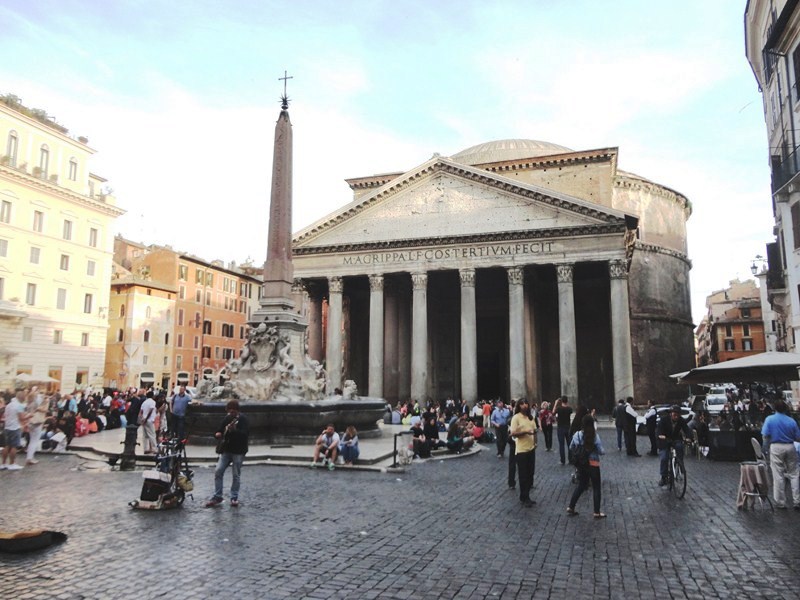
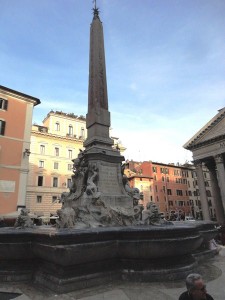
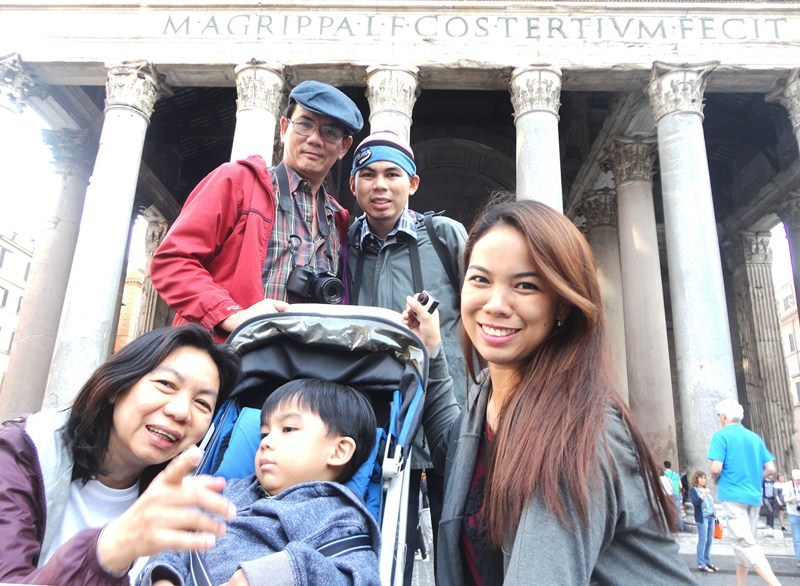
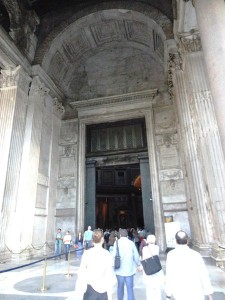
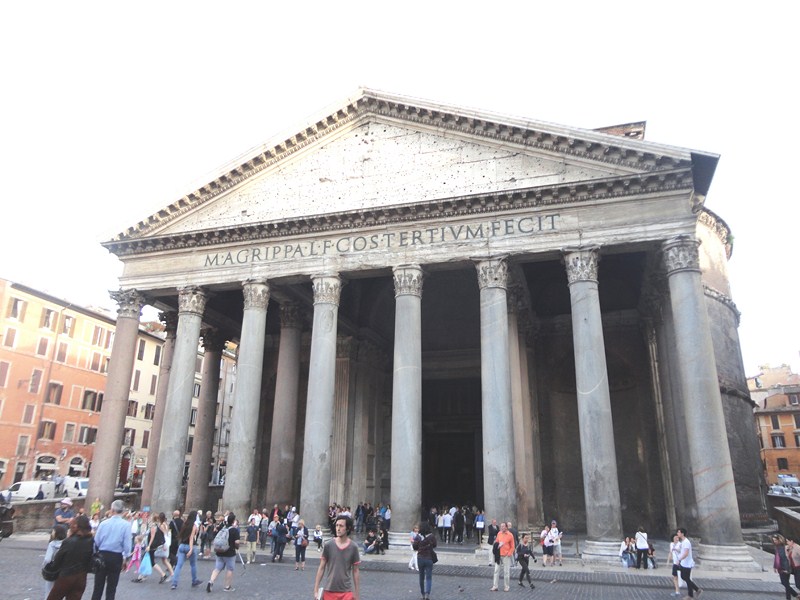
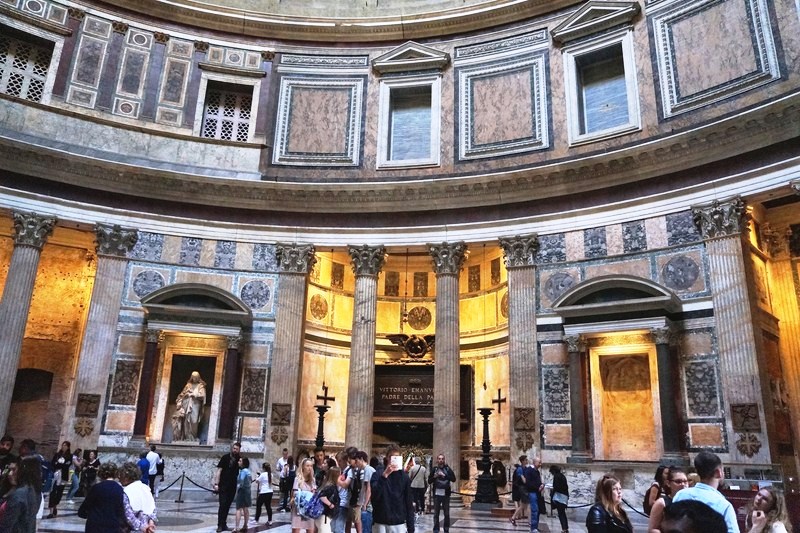
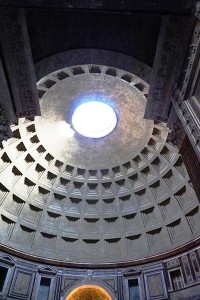
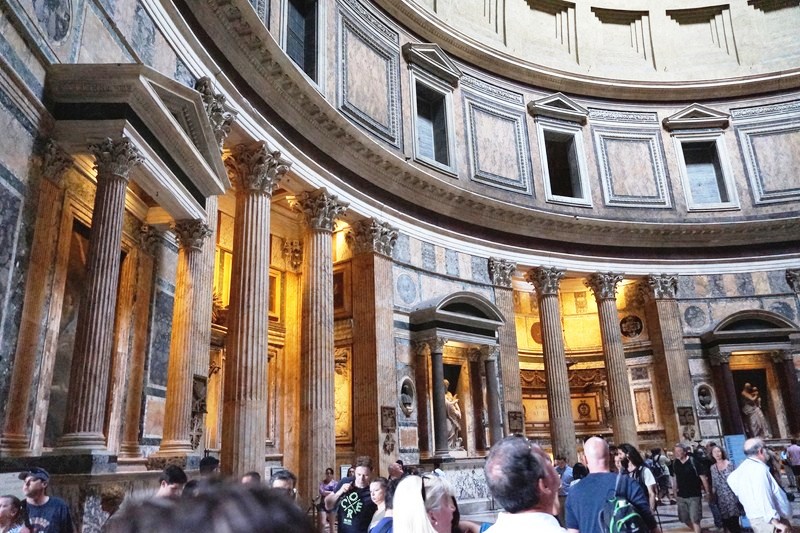
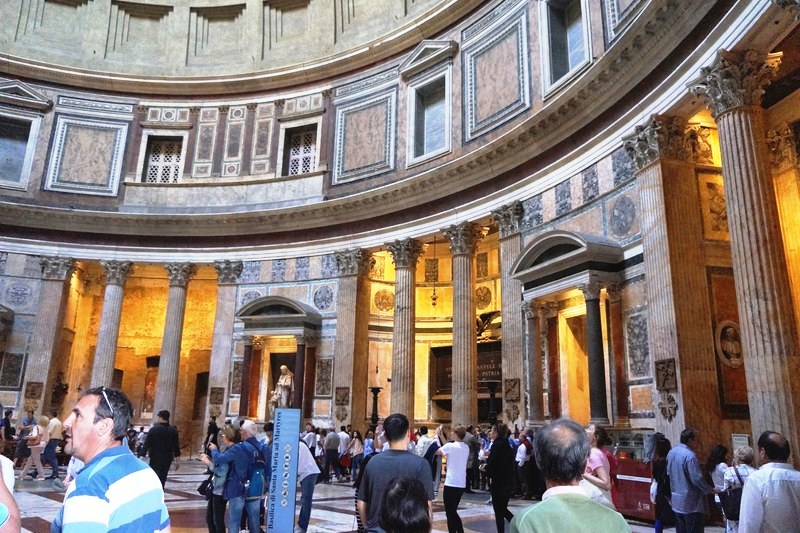
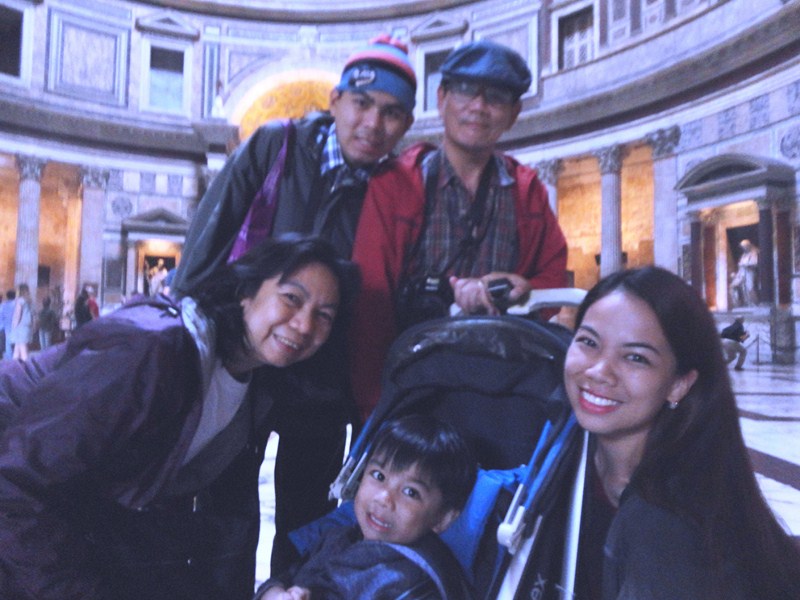
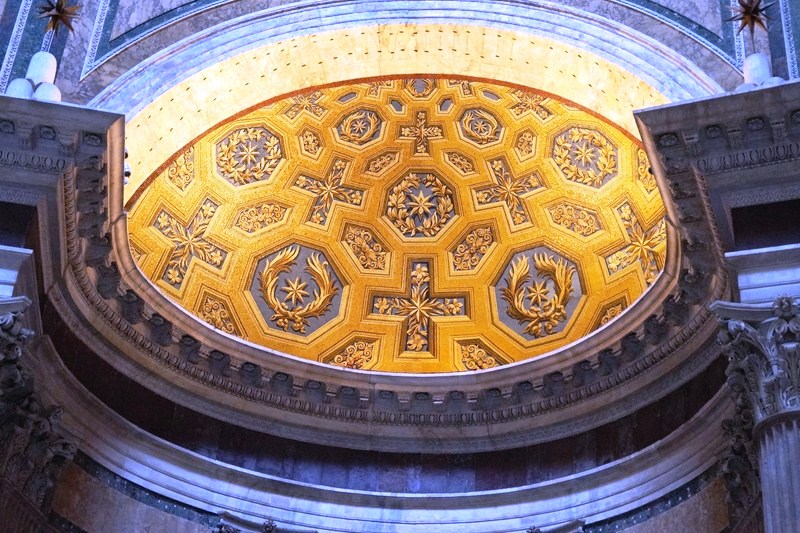
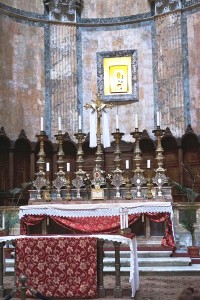
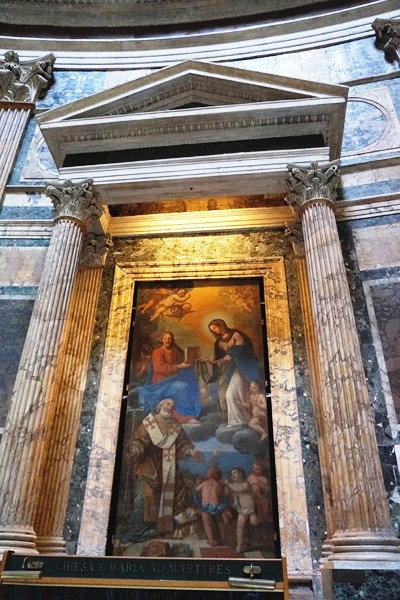
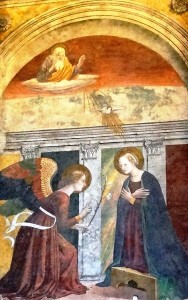
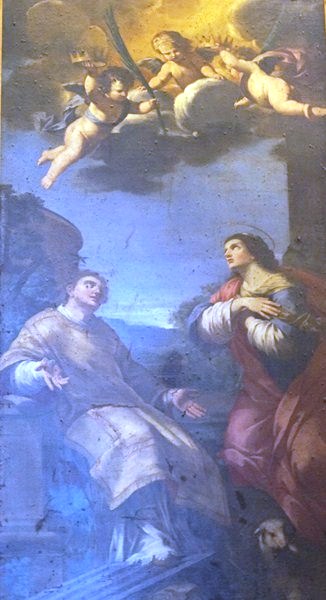
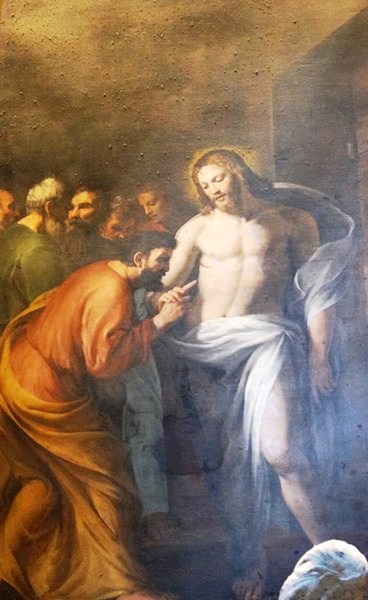
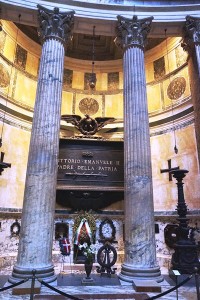
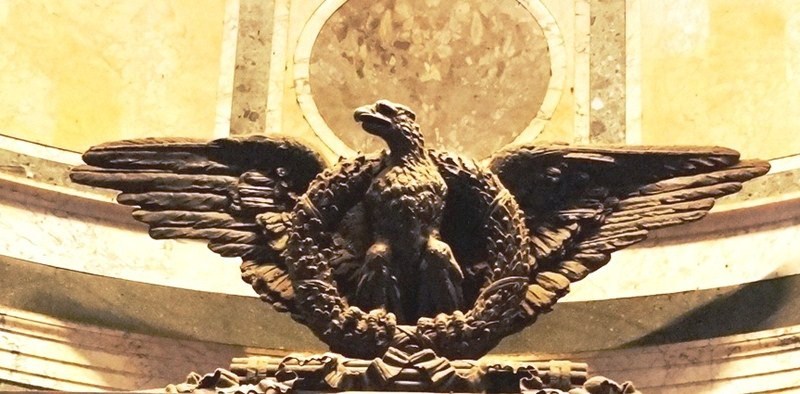
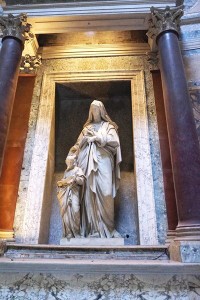
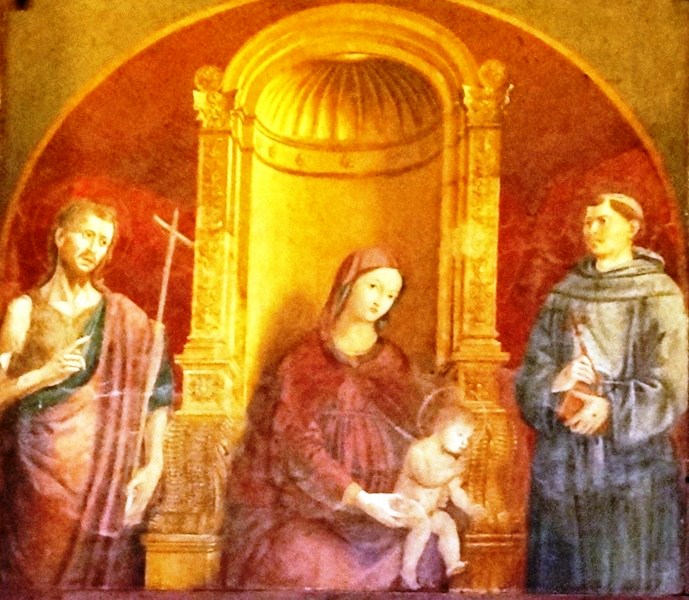
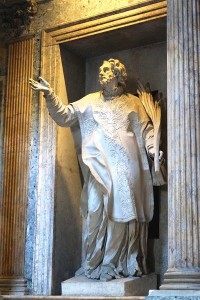
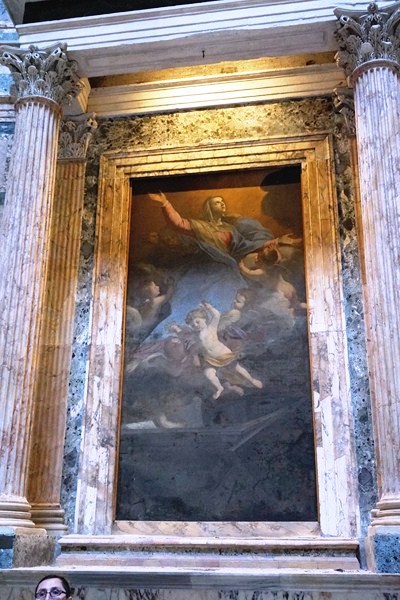
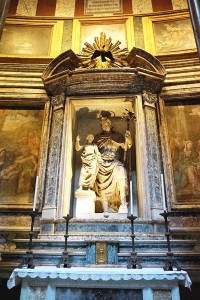
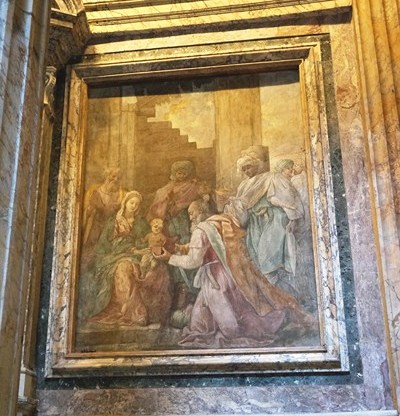
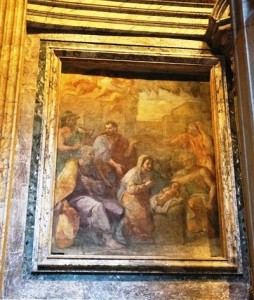
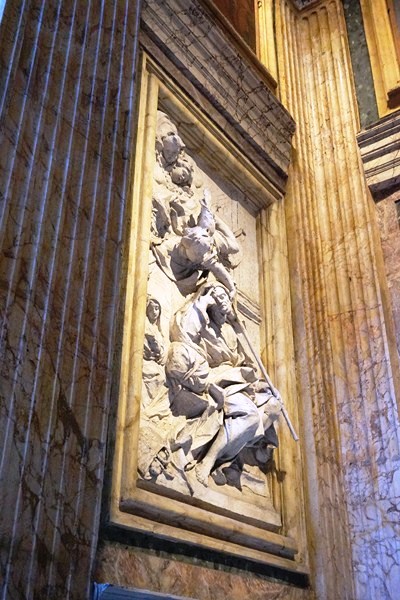
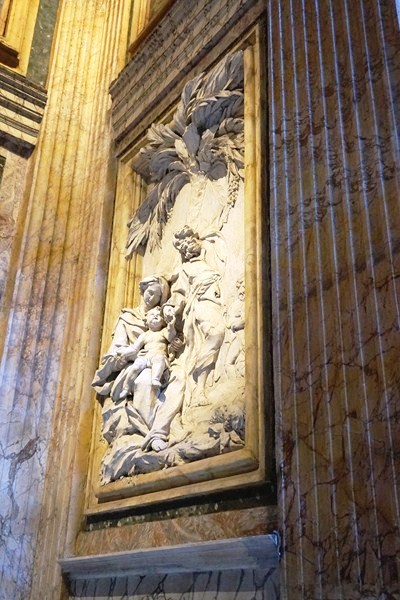
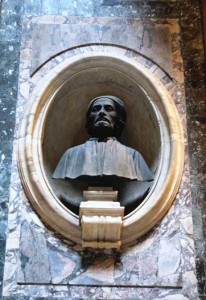
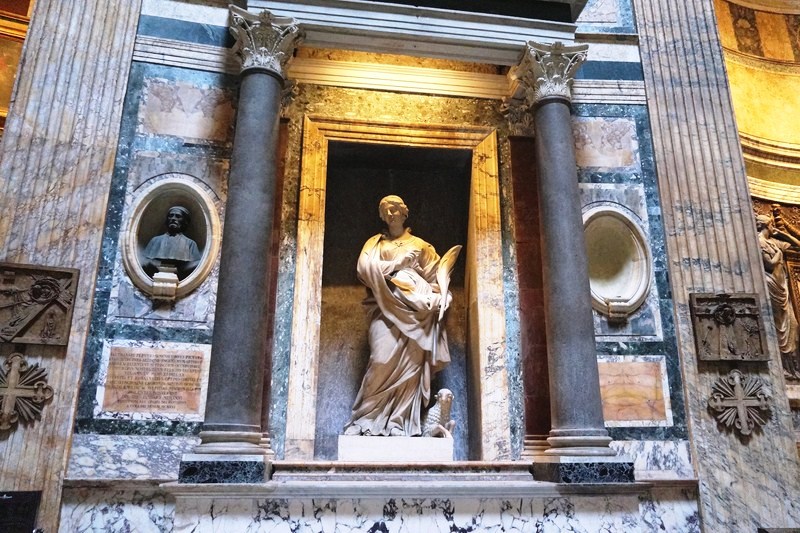
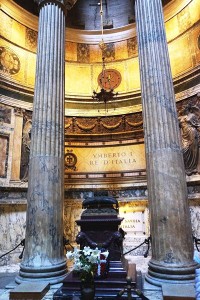
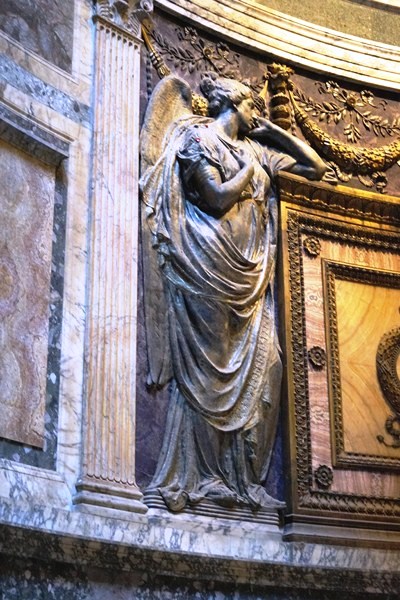
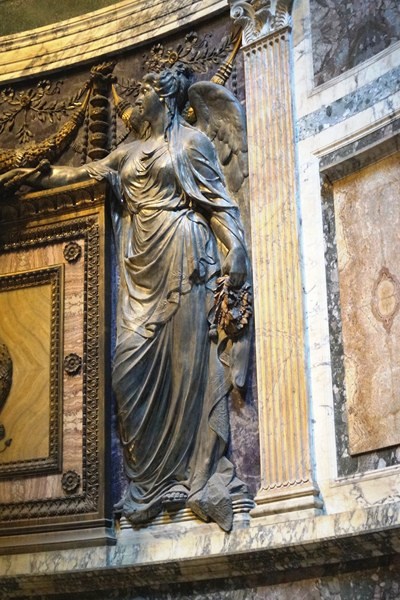
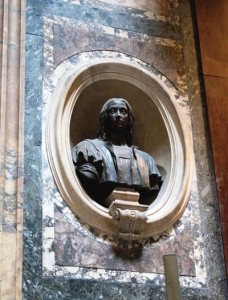
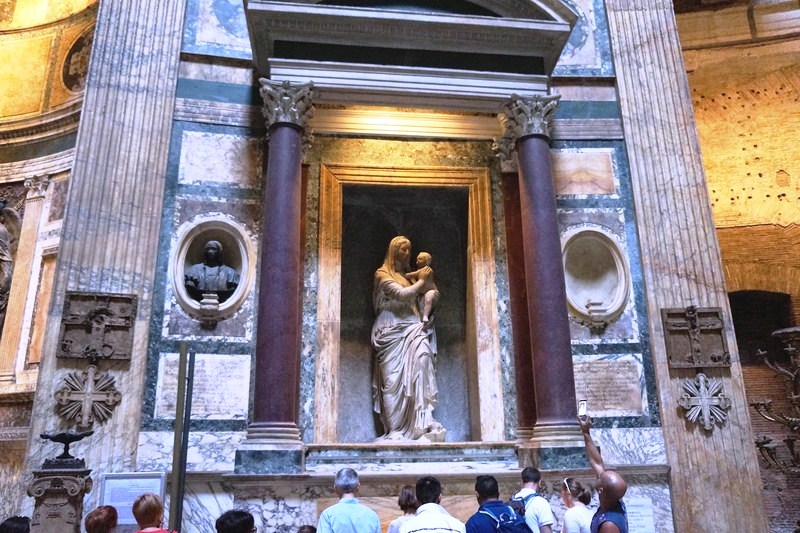
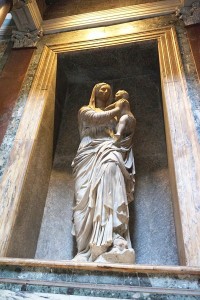
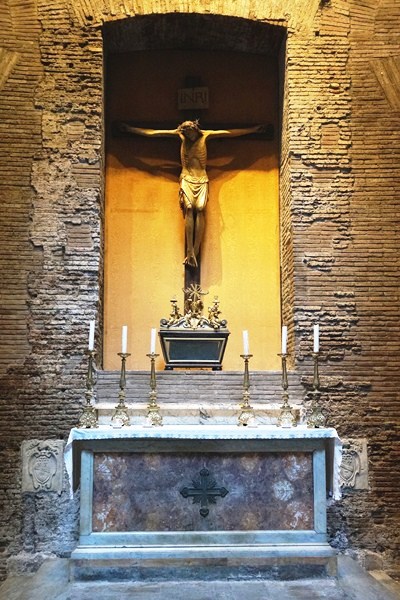
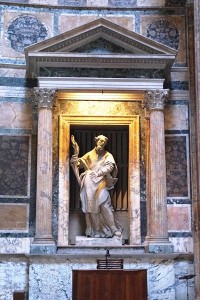
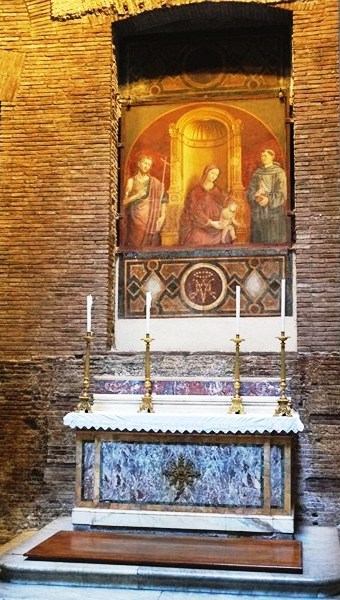
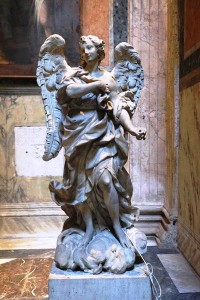
Pingback: My Homepage